The pape art technique is quite new, but already a type of handicraft that has gained immense popularity, created in 2006 by the craftswoman Tatyana Sorokina, and representing the decoration of dishes, the creation of various panels and paintings using paper napkins twisted in a certain way.
The finished products obtained as a result of the work resemble exquisite, antique, as if made of metal or glass, luxury items using forging, carving or embossing, while not requiring large expenditures.
General characteristics
The paper art technique can be used to decorate any surface, and it itself is translated from English as “paper art”, precisely indicating the main element used in the work.
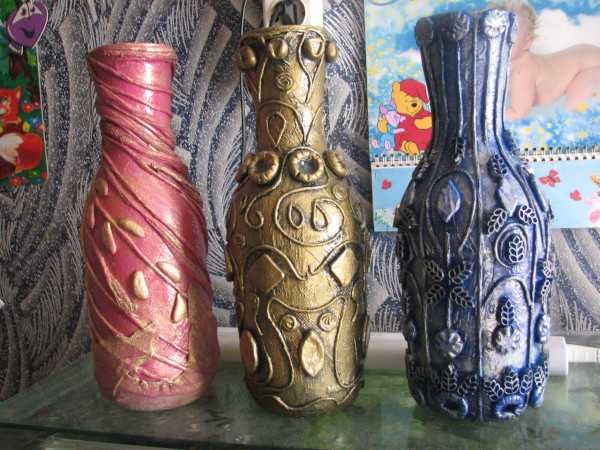
This trend, which appeared in 2006, is characterized by the use of specially twisted “flags” of two-layer or single-layer paper napkins to create various textures that precisely imitate more expensive and energy-intensive work – embroidery, metal-plastic, chasing, wood carving.
The main advantage of the technique is the possibility of its application on almost any surface for decorating and updating old kitchen utensils, wooden items, and glass bottles.
Using elements that imitate metal forging, experienced craftsmen can turn a cardboard shoe box into an antique chest, create exclusive watches, dishes or decorative figurines.
The pipe art technique is also used to create various panels and paintings on cardboard, wood or glass bases.
This artistic technique has no similarities with decoupage, since it involves creating a completely new, three-dimensional pattern from paper flagella, without using ornaments and designs already applied to the work surface.
Story
For the first time, such products were presented in 2006 at a children's art exhibition, and subsequently the popular technique began to be successfully taught in art schools, thanks to textbooks compiled directly by its founder, the head of the Aquarelle studio, Tatyana Sorokina.
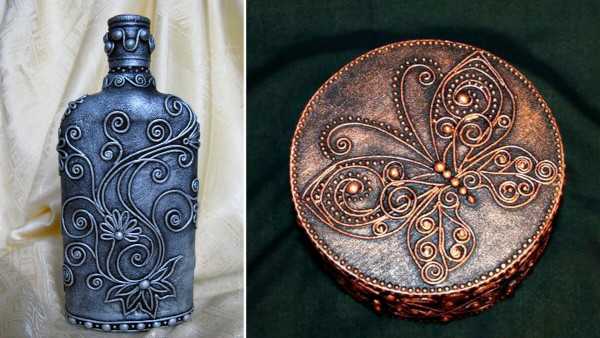
According to the master herself, the idea for the technique came to her completely by accident, when during one of the classes at the children's art studio "Akvarel" she decided to try something new and unusual and suggested that the children decorate cardboard boxes with flagella twisted from napkins.
The children and the master himself really liked the process of decorating, and the finished crafts became laureates of the international creative competition. Initially, Tatyana Sorokina called her method "napkin plasticity", and then decided to rename it, since in creating the decor she began to use not only napkins, but also corrugated colored paper.
Rhinestones, beads and other accessories also began to be used as an addition to paper ornaments. Subsequently, the head of the art studio "Aquarelle" published several books, methodological manuals on the production and decoration of various products with paper flagella.
Popular colors and patterns
The pipe art technique is aimed at creating items that resemble antique, embossed relics in appearance, and can be used to transform virtually any object, including glassware and furniture.
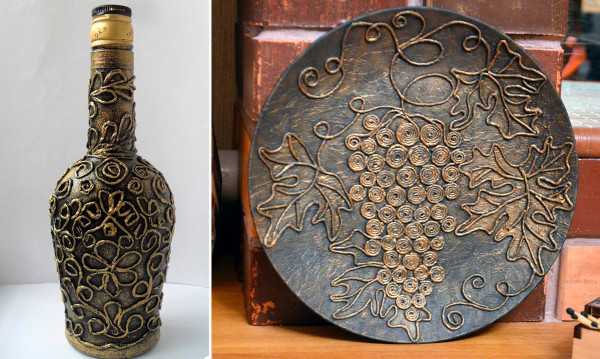
Using napkins or paper of similar quality, twisted into flagella in a special way, the craftsmen manage to recreate a decor reminiscent of a clay, embossed or carved ornament.
The pattern applied to dishes, cardboard products or walls can be anything, but the most impressive will be an ornate ornament, floral or geometric decor.
The technique of paper decoration, pipe art, allows you to create imitation of antique items made of clay, metal or wood, which look most organic in light or dark brown shades.
Quite often, masters who are adherents of the steampunk style also use metallic-tinted paints in their work, creating an imitation of a stamped pattern on the finished product. To create the illusion of antique porcelain products made in the minimalist style, white paint is used, completely covering the products decorated with napkins.
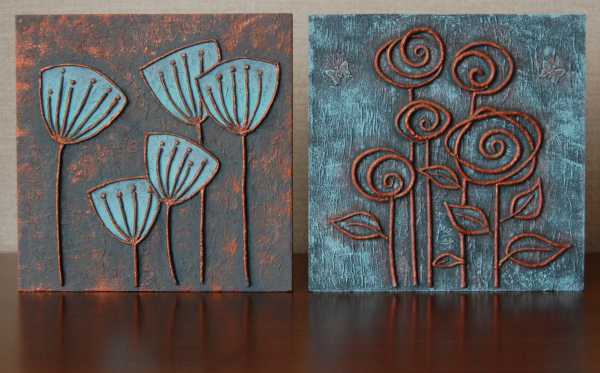
Also popular are:
- dark green, turquoise shades (for glass products);
- golden, bronze color (for coins, watches and imitation items made of precious metals);
- neon colors (used in creating paintings and panels).
It is also permissible to add a variety of bright color accents – red, blue, yellow, purple – to a single-color product (for example, a light brown product).
Materials used
The pipe art technique does not require special training, and anyone can master the art of decor by taking master classes based on Tatyana Sorokina's methods. The specialist advises starting with simple elements - dishes, bottles, cardboard boxes, gradually moving on to more complex items and interior details.
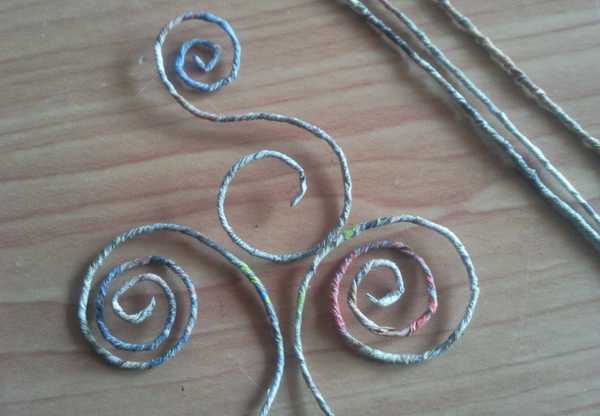
The tools and materials used in the work are widely available:
| Type of material | How to use |
| Napkins | Experts advise starting work with purchasing plain, white, single-layer or multi-layer napkins without additional patterns, which are easily twisted into flagella and take the desired shade. It is not recommended to use material with a relief surface, which is more difficult to take a given shape. |
| Water | A glass or porcelain bowl of water is needed to moisten the paper and make the rolling process easier. |
| PVA glue | With a thick consistency, it should also have a hypoallergenic composition, which will significantly facilitate the long process of work and help to avoid unwanted allergy symptoms. |
| Sketches or stencils | They are selected at the discretion of the novice master and are used to create an original pattern. |
| Tweezers or toothpicks | Necessary for alignment and correction of the finished pattern. |
| Towel | Used to remove excess liquid from decor that could soften the adhesive. |
| Paints | It is recommended to use aerosol cans, acrylic paints or gouache for work, avoiding watercolor paints with a more watery composition. |
| Additional elements: |
|
Consumables can be purchased at any hardware or office supply store at an affordable price. Also, experts recommend purchasing only high-quality napkins and glue for work, which will help avoid greasy stains on the surface of the product and facilitate the process of gluing decorative elements.
Preparation
Decorating using the pipe art technique begins with the preparation process, during which the novice master must decide on the type of product, select a suitable pattern and color palette. Experts advise starting work with decorating bottles, panels or paintings, applying an ornate pattern to them.
It is also recommended to print out the pattern you like in advance and apply it to the surface of the object. You can come up with a pattern yourself, draw it, or decide on it in the process of work, using your imagination.
The material selected for decoration must be cleaned of dirt (when using bottles), remove stickers and old paint (when decorating interior items, walls), and degrease its surface with an alcohol solution.
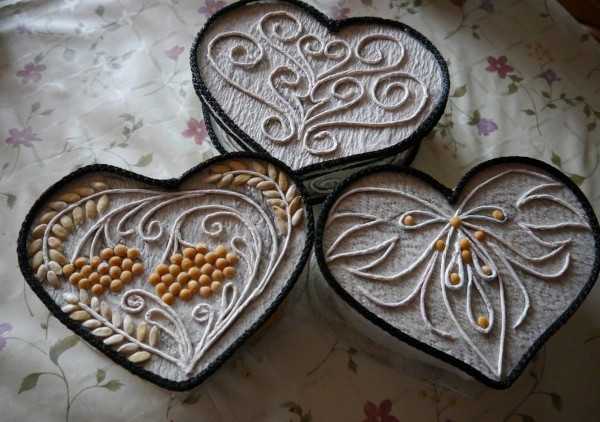
- When working with wooden products, their lids and walls need to be sanded, processed with sandpaper. After this, a layer of PVA glue should be applied to the selected product, napkins or paper towels should be applied to its surface, they should be stretched well, which will prevent the appearance of air bubbles, pressed with hands and glued. A pattern stencil should be applied to the dried paper and using tracing paper, it should be transferred to the box.
- When decorating a bottle, you need to apply a selected color background (for example, bronze) to its surface. To do this, using a brush, you first need to treat the surface with a layer of PVA glue, and as soon as it dries, apply paint (acrylic or gouache).
Making flagella
As decorative elements in the decorative technique of paper art it is assumed to use flagella twisted in a special way from paper napkins, to create which you will need:
- Using a ruler, divide the napkin (preferably completely white) into several strips, each 3 cm wide.
- Wet the brush in a container of water and then run it over the stripes, moistening them well.
- Place a drop of PVA glue on top of the strip, spread it evenly over the paper, and then twist it into a tourniquet.

The finished wet parts can be used immediately to create patterns, and if they dry out, use a spray bottle to lightly spray the material with water.
You can also form flagella from a napkin without using a brush, for which you can dip the napkin cut into strips into a container with water with your hands and immediately form flagella from them by rolling the paper from one edge to the other. To fix them, you can first apply a small amount of PVA glue.
Decoration of products
Once you have prepared the materials, you can begin the decoration process itself:
Bottle in pipe art technique
To decorate a bottle or any other glass vessel, in addition to the basic elements, you will also need:
- a set of multi-colored gouache;
- acrylic paint (bronze, copper, metallic);
- various shapes of pasta, wheat and rice grains for additional decoration.

When decorating you need to:
- Using a brush, cover the outline of the bottle, which has undergone preliminary preparation, cleanly washed and primed with acrylic paint, with PVA glue (in 2 layers) and attach paper flagella to it. Each of the decorative elements should be securely fixed to the surface, for which it is recommended to leave it under a brush moistened in glue for a few seconds.
- Using similar techniques, lay out the desired ornament from the flagella, and then, if desired, add pasta, rice and wheat grains, laying them on the surface using tweezers. All elements placed on the bottle must be pressed for a few seconds with a brush and glue to secure them.
- If necessary, the created pattern can be carefully adjusted with a toothpick, and then covered with an additional layer of glue. After it dries, you should first apply a second and then a third layer of glue.
- To paint the pattern, mix different colored gouache (for example, black, green and red) in a separate container, then add acrylic varnish (in a 1:1 ratio) and mix well. If necessary, you can pour 20-30 ml of water into the resulting mixture.
- Using a foam sponge, apply paint to the decorated part of the bottle in 2-3 layers (each new layer can be applied only after the previous one has dried). As soon as it dries, spray the entire surface of the bottle with cosmetic hairspray, having previously shaken the can well.
Casket in pipe art style
To create a box with decor using the paper art technique, you will need a pre-prepared, sanded, paper-glued wooden base. Instead, you can also use a box made of thick cardboard. It also needs to be coated with PVA glue several times during the preparation process, and then a layer of paper should be applied.
For work you also need:
- keroplast (a clay-like material that instantly hardens in the air and is used for modeling);
- acrylic paint (you can use black (or brown) and gold colors).
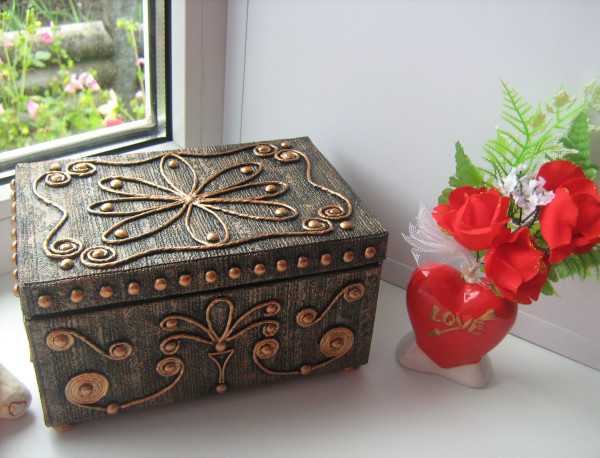
When decorating the prepared base, you need to:
- Apply PVA glue to the box lid (wooden base) with a brush, and then lay out the desired pattern with paper flagella according to the diagram or stencil. When applying each element, press it for a few seconds with a brush dipped in glue.
- Similarly, you need to decorate the legs and sides of the box.
- From keroplast, mold large flowers and leaves and carefully glue them with PVA glue to the lid of the box. To create veins on the leaves, you can use a toothpick.
- Using a wide brush, cover the item with a dried pattern with black paint. It should be applied in 2-3 layers, with each new one applied only after the previous one has dried.
- Using a foam sponge, lightly shade the protruding parts of the pattern with gold paint, and then use a brush to apply varnish to the entire surface of the box.
- At the final stage, the inside of the box should be draped with velvet or satin fabric using a hot glue gun, and a small mirror should be glued under the lid. A small pillow for jewelry made of velveteen can also be placed inside the box.
Plate in pipe art style
You can decorate any small glass plate (20 cm in diameter) with paper flagella.
The work will also require:
- Titan glue;
- pea seeds (for additional decoration);
- acrylic paint in dark brown and bronze shades;
- stencil with a pattern. You can lay out the flagella in any order.
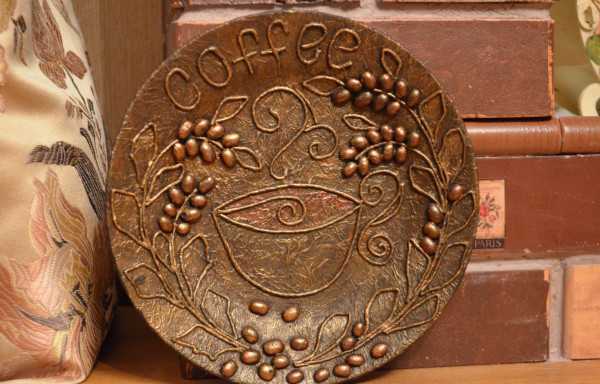
The decoration process requires:
- Wash the plate, dry it, transfer the selected pattern from the stencil onto it, and then coat it with PVA glue (in 2 layers).
- Twist paper napkins into flagella, apply a layer of glue to the plate and place the flagella in accordance with the chosen pattern.
- Divide the peas into halves and add decorations using Titan glue.
- Once the glue has dried, cover the plate with the pattern with 2-3 layers of dark brown paint (each new one is applied only after the previous one has dried), and then, using a sponge soaked in bronze-colored paint, shade the protruding parts of the decor.
- The final touch will be applying varnish to the surface of the finished plate. If you don’t have any, you can use a can of cosmetic varnish.
Advice from experts
The pipe art technique does not require any special skills and can be easily mastered by anyone.
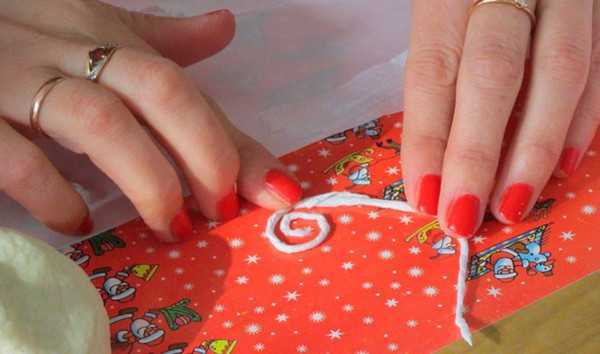
Experienced craftsmen also advise beginners:
- Use a thin towel when rolling the flagella. Its fabric instantly absorbs excess moisture, preventing the paper from spreading, and also makes the decorative elements more even, which significantly simplifies the subsequent process of creating a pattern.
- If necessary, replace napkins at work with paper towels or handkerchiefs, toilet paper.
- It is necessary to use a sprayer in the work, which allows you to wet the flagella in a timely manner, making them more pliable. It is almost impossible to work with dried material.
- Create an even spiral pattern or circle using a fine-toothed comb or wooden skewer.
- Dilute PVA glue with water (in a 1:1 ratio) for the final coating and fixing of the pattern.
- If you wish, combine paper art with other techniques (for example, decoupage), using paper flagella for decoration with volumetric elements.
Pipe art is a popular, innovative technique of decorative and applied art developed by a Russian master. Aimed at creating three-dimensional patterns from napkins or other similar materials twisted in a special way, it helps to create original, antique-style products and interior items, is easy to use and does not require large financial investments.
Video about the technique of Pape-art
Pipe art for beginners:
